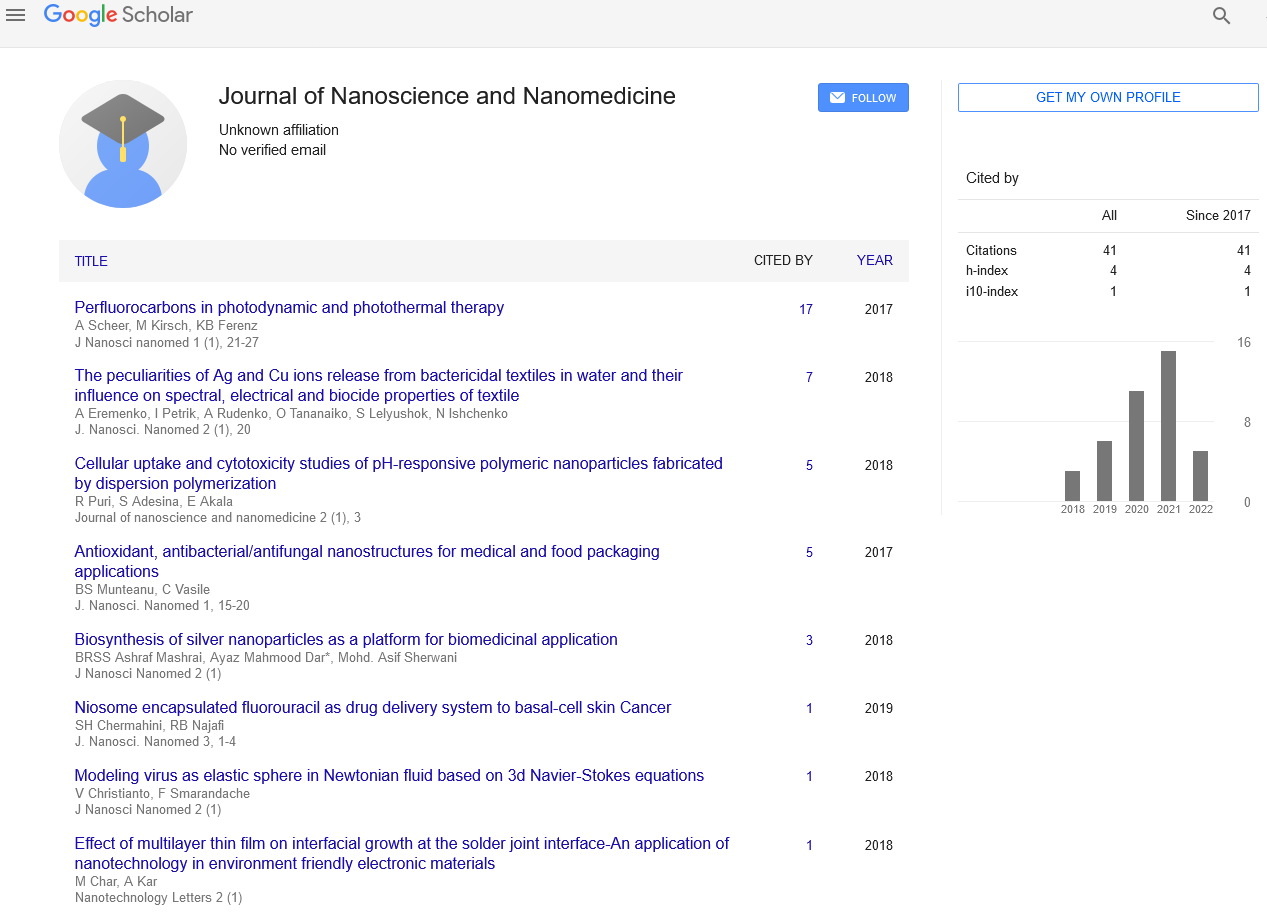Nano-bio-imaging and therapeutic nanoparticles
2 Institute of Physiology, University of Duisburg-Essen, University Hospital Essen, Germany and CeNIDE (Center for Nanointegration Duisburg-Essen) University of Duisburg-Essen, Germany, Email: katja.ferenz@uk-essen.de
Katja B. Ferenz, Institute of Physiology, University of Duisburg-Essen, University Hospital Essen, Hufelandstr 55, 45122 Essen, Germany and CeNIDE (Center for Nanointegration Duisburg-Essen) University of Duisburg-Essen, Carl-Benz-Strasse 199, 47057 Duisburg, Germany, Tel: (49) 201-723 4106, Email: katja.ferenz@uk-essen.de
Received: 08-Jun-2018 Accepted Date: Jun 11, 2018; Published: 18-Jun-2018
Citation: Katja Ferenz, Cheng Zhang. Nano-bio-imaging and therapeutic nanoparticles. J Nanosci Nanomed. June, 2018;2(1):19-20.
This open-access article is distributed under the terms of the Creative Commons Attribution Non-Commercial License (CC BY-NC) (http://creativecommons.org/licenses/by-nc/4.0/), which permits reuse, distribution and reproduction of the article, provided that the original work is properly cited and the reuse is restricted to noncommercial purposes. For commercial reuse, contact reprints@pulsus.com
Bio-imaging and therapeutic nanoparticles-initially two different research areas tend more and more to merge. The outcome? Highly sophisticated imaging techniques offering new insights in nature or reducing side-effects of clinical therapies-a perfect symbiosis. This symbiosis is reflected in large improvements of medical diagnostics and therapy and even led to the formation of a completely new approach named “theranostics”, the fusion of the two areas therapeutics and diagnostics.
Imaging of biological tissue dates back to 1900’s. The X-ray illumination of the hand of Wilhelm Roentgen's wife in 1895 was the first medical image exposing the unseen world inside the living body. In parallel, the synthesis, characterization and use of nanoparticles advanced leading inescapably to the idea to combine both fields. If nanoparticles can be used to specifically deliver drugs to target tissues why shouldn´t they transport e.g. contrast agents necessary for clinical imaging?
Imaging-based diagnostics are an important tool in modern medicine. The detection limit could be shifted widely downwards through nanoparticle (NP)-assisted bio-imaging, thus realizing very early detection of diseases such as cancer. Thanks to nanoparticles highly effective bio-imaging techniques now allow for detection of very small tumor entities that otherwise would have been overlooked; one major contributor to a reduction in mortality of patients. These NPs have many advantages including real time monitoring, minimal or no invasiveness, accessibility without tissue destruction and can be functionalized to take effect over a wide range of time (from milliseconds to years) and size scales (from molecular level to the whole organism) involved in the imaging processes [1]. Depending on the imaging technique used, it can be e.g. magnetic/ metallic nanoparticles (magnetic resonance imaging [2,3], in-vivo stem cell tracking [4]), reporter dyes/fluorophores in the nanoscale (immunoassays [5], in-vivo fluorescent imaging [6], in-vivo stem cell tracking [4]), radiolabeled nanoparticles (positron emission tomography, single-photon emission computed tomography, Cerenkov luminescence [7]) and so on.
Besides diagnostics, nanoparticles can also be used for therapy. Specific targeting is of utmost importance in order to avoid or reduce side-effects of toxic drugs or procedures. In the context of nano-bio-imaging this means, that nanoparticles are used to render non-specific treatments specific and thus highly effective and less destructive, e.g. photodynamic and photothermal therapy are much better tolerated by patients when the required photosensitizers (and oxygen in case of photodynamic therapy) are delivered very locally to the target tissue; managed by their incorporation in nanoparticles [8]. Not until with the aid of nanoparticles it is possible to generate noxious reactive oxygen just exactly where they are needed inducing oxidative stress or creating cell-hostile hyperthermia only locally [8].
Beyond all the named improvements due to fusion of nano-research and bio-imaging the most exciting actual development is the emergence of a new approach called “theranostics”. As already visible by this portmanteau word, therapeutic and diagnostic qualities are combined in nanoparticles with multimodal functions. Among them also nanoparticles designed to visualize and additionally destroy cancer tissue. Recent examples are magnetic resonance imaging-guided photothermal or photodynamic therapy by gadolinium oxide/chlorine e6 loaded nanoparticles (Gd2O3@BSA conjugating Cle6) [9] or (even one step further) the combination of fluorescence imaging, photothermal therapy and chemotherapy realized by indocyanine green/ paclitaxel-loaded nanoparticles (HSA-PTX-ICG nanoparticles) [9].
Only the combination of bio-imaging with nanoscience led to this success. The tremendous improvement of all these imaging techniques is crucial to guarantee the best possible outcome of the patient. To underline the importance of this new field we launched this special issue of the Journal of Nanoscience and Nanomedicine. We believe that the development in this new field will guide earlier detection and thus permit earlier treatment for human diseases.
REFERENCES
- Fass L. Imaging and cancer: A review. Mol Oncol. 2008;2:115-52.
- Moonshi SS, Zhang C, Peng H, et al. A unique 19F MRI agent for the tracking of non-phagocytic cells in-vivo. Nanoscale. 2018;10:8226-39.
- Zhang C, Moonshi SS, Han Y, et al. PFPE-Based Polymeric 19F MRI Agents: A New Class of Contrast Agents with Outstanding Sensitivity. Macromol. 2017;50:5953-63.
- Rijt Sv, Habibovic P. Enhancing regenerative approaches with nanoparticles. J R Soc Interface. 2017;14.
- Runnels JM, Zamiri P, Spencer JA, et al. Imaging Molecular Expression on Vascular Endothelial Cells by In Vivo Immunofluorescence Microscopy. Mol imaging. 2006;5:31-40.
- Braeken Y, Cheruku S, Ethirajan A, et al. Conjugated Polymer Nanoparticles for Bioimaging. Materials. 2017;10.
- Pratt EC, Shaffer TM, Grimm J. Nanoparticles and radiotracers: advances toward radionanomedicine. Wiley interdisciplinary reviews. Nanomed nanobiol. 2016;8:872-90.
- Scheer A, Kirsch M, Ferenz KB. Perfluorocarbons in photodynamic and photothermal therapy. J Nanosci nanomed 2017;1:21-7.
- Gou Y, Miao D, Zhou M, et al. Bio-Inspired Protein-Based Nanoformulations for Cancer Theranostics. Front pharmacol. 2018;9: 421.





